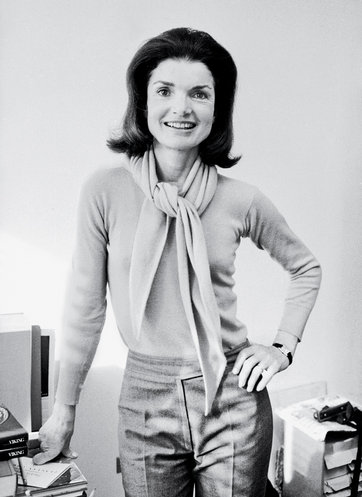Jacqueline Kennedy Onassis: An Autobiography in Books
By
Jesse Kornbluth
Published: Dec 05, 2010
Category:
Biography
In 1986, I wrote a cover story for New York magazine called “The Working Rich: The Real Slaves of New York." My focus was on Carolyne Roehm, a designer of clothes for ladies who lunch, and her husband, Henry Kravis, a dominant player in the leveraged buyout game. They worked hard, they were out every night, they lived extravagantly well — they were the envy of many. And because I had a lot of access to Roehm and Kravis, I caught them in the act.
A few days later, a breathy, girlish voice was on the phone, and Jacqueline Onassis was asking, “Would you like to turn that amazing piece into an Edith Wharton novel?”
Excellent idea! At the time, her employer wasn’t known for literary fiction, but I was quite sure that if Mrs. Onassis wanted to publish a novel in the manner of Edith Wharton, Doubleday would go along. But I was under contract to another publisher for a book that wasn’t jelling. I told Mrs. Onassis I’d see if I could find an exit. And I said I’d try to call her back within the week.
“Will you remember?” she asked.
“Mrs. Onassis,” I replied, “do you seriously think I could forget?”
Alas, I couldn’t get out of my book contract, or I like to think my Society novel would be an anecdote in of one of the two new books about Mrs. Onassis’ three decades in publishing.
Greg Lawrence, who was one of her writers, is the author of “Jackie as Editor: The Literary Life of Jacqueline Kennedy Onassis.” [To buy the book from Amazon,
click here. For the Kindle edition,
click here.]
William Kuhn is the author of “Reading Jackie: Her Autobiography in Books.” [To buy the book from Amazon,
click here. For the Kindle edition,
click here.]
Unsurprisingly, the writers are not fond of one another.
Greg Lawrence’s take on William Kuhn: “Jackie wouldn’t have hired this other writer to take out her laundry.”
William Kuhn’s take on Greg Lawrence: “When I interviewed Jackie’s colleagues from Doubleday, they said the impression Greg Lawrence made on them while she was working with him was unequivocally that he was a difficult man.”
As it happens, Kuhn’s publisher pushed the publication date forward and only his book is available. Makes my job easier. [Disclosure: Kuhn interviewed me. Lawrence didn’t.] Anyway, they both seem to make the same argument — Mrs. Onassis, who was famously private, “wrote” what is essentially her “autobiography” in the books she chose to publish.
There’s a picture at the front of “Reading Jackie” that is, Kuhn says, quintessential: Mrs. Onassis reading as she walks along Fifth Avenue. The First Lady, First Widow, Wife of Onassis, Mother of John and Caroline — these were skins she put on and shed. But reading was forever.
At Miss Porter’s School, Jackie was a loner; she preferred books to friends. On the Onassis yacht, she never napped after lunch; she read. She once fired a maid, who took her revenge in a magazine article. Her gripe: Jackie spent so much time reading that she was sometimes late for dinner.
As a girl, she was a talented writer. But writing was hard, painful work, and she lacked confidence; she didn’t think she’d come near the achievements of her idols. Then she got distracted — “I have always lived through men,” she said — and retreated into reading.
In 1975, after Onassis died, she signed on as an editor at Viking. Her salary was typical for publishing: $10,000 a year. In every other way, her deal was different. She worked just three days a week and left the office after lunch. All three months of the summer, she was on Martha’s Vineyard. Not goofing, though — she reveled in her work.
Two years later, Viking published a novel that came too close to her personal history, and she moved on to Doubleday. She was still a bit green. When her friend Carly Simon wanted to do a book, her superiors authorized an advance of $250,000, but told Jackie to start at $150,000. Simon’s lawyer thought $150,000 was just fine. Jackie’s view: “We’re screwing Carly.”
Jackie was a friend to women. But she was an irresistible to men. “I did everything she told me to do,” the legal counsel to the Metropolitan Museum remarked. “We all did.”
Because she was such a magnet for authors, Kuhn argues, she could pretty much choose what she wanted to publish — and in her choices “she commented in the most public way possible what she thought of the institution of marriage, about presidential mistresses, about what it was like to have a career in order to circumvent unhappiness in a marriage, about Marilyn Monroe’s sex appeal and Maria Callas’s eyes, and about how a woman might guard her privacy in the midst of a marriage the world regards as public business.”
From there, Kuhn deals quite specifically with books and authors and the editing process. Yes, it’s very much like a psychiatric analysis. But it’s also inside baseball, and there are many readers who will start skimming. Too bad — there’s a lot of great dish here and, because Kuhn has clearly learned more about his subject than he can use, there are arrows to conclusions about this woman that have nothing to do with books.
Jacqueline Onassis was nothing if not careful about revelations of her personal life. That will continue. As Kuhn writes, “She included in her will a line instructing her child to resist the publication of her letters.” So until a biographer comes along with the patience, the skill and the connections to get the still-untold story of Jacqueline Onassis’ life, Kuhn has it right — by her work shall we know her.
To read the prologue to William Kuhn’s book,
click here.


